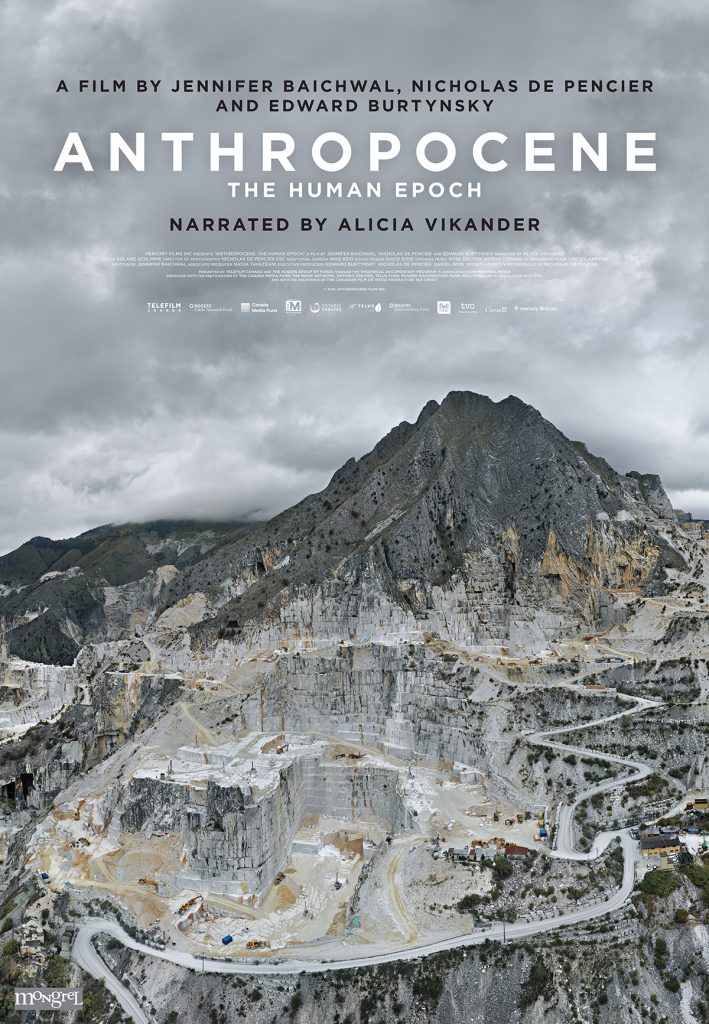https://theanthropocene.org/film/
A film that has just been released in Canada
ANTHROPOCENE: THE HUMAN EPOCH
THE DOCUMENTARY

'A cinematic meditation on humanity’s massive reengineering of the planet, ANTHROPOCENE: The Human Epoch is a four years in the making feature documentary film from the multiple-award winning team of Jennifer Baichwal, Nicholas de Pencier and Edward Burtynsky.
Third in a trilogy that includes Manufactured Landscapes (2006) and Watermark (2013), the film follows the research of an international body of scientists, the Anthropocene Working Group who, after nearly 10 years of research, are arguing that the Holocene Epoch gave way to the Anthropocene Epoch in the mid-twentieth century, because of profound and lasting human changes to the Earth.
From concrete seawalls in China that now cover 60% of the mainland coast, to the biggest terrestrial machines ever built in Germany, to psychedelic potash mines in Russia’s Ural Mountains, to metal festivals in the closed city of Norilsk, to the devastated Great Barrier Reef in Australia and surreal lithium evaporation ponds in the Atacama desert, the filmmakers have traversed the globe using high end production values and state of the art camera techniques to document evidence and experience of human planetary domination.
At the intersection of art and science, ANTHROPOCENE: The Human Epoch witnesses in an experiential and non-didactic sense a critical moment in geological history — bringing a provocative and unforgettable experience of our species’ breadth and impact.'
Third in a trilogy that includes Manufactured Landscapes (2006) and Watermark (2013), the film follows the research of an international body of scientists, the Anthropocene Working Group who, after nearly 10 years of research, are arguing that the Holocene Epoch gave way to the Anthropocene Epoch in the mid-twentieth century, because of profound and lasting human changes to the Earth.
From concrete seawalls in China that now cover 60% of the mainland coast, to the biggest terrestrial machines ever built in Germany, to psychedelic potash mines in Russia’s Ural Mountains, to metal festivals in the closed city of Norilsk, to the devastated Great Barrier Reef in Australia and surreal lithium evaporation ponds in the Atacama desert, the filmmakers have traversed the globe using high end production values and state of the art camera techniques to document evidence and experience of human planetary domination.
At the intersection of art and science, ANTHROPOCENE: The Human Epoch witnesses in an experiential and non-didactic sense a critical moment in geological history — bringing a provocative and unforgettable experience of our species’ breadth and impact.'
Such a description for the film furthers the arguments already made about Burtynsky's practice. Although breathtaking, the language promoting the film as meditative is somewhat astonishing. The beautiful shots depicted that (one needs reminding) is of destructive practices, does not make the audience wake-up to the current global situation, but instead accept–as they are being told but an authoritative film institution–the Anthropocene, in a disavowing and whitewashing way. However before the argument simply looked at his images in a gallery context, they are now in a feature film that communicates to a mass audience. Such is an example of anthropocentric design, finding aesthetic and vibrancy in large scale projects that reject the intricacies and necro-politics of its practice.
Examples of the public reviews that emulate this:
Examples of the public reviews that emulate this:
- 'A stunning wakeup call, and thanks to the travel, work and thought of the filmmakers, it is equally stunning to look at.'
- 'The filmmakers' stunning images, captured around the world, make it clear that whenever it started, it is ongoing.'
- 'There's no denying the images are stunning.'
- 'As always, the images they capture are stunning and damning in equal measure.'
- 'While the film's urgency comes across, its beautiful and bizarre moments also push the doc toward abstraction.'
- 'Stunningly, even hypnotically shot - from the world's largest landfill in Kenya, to the most polluted city in Russia (Norilsk, Siberia) to tons of tusks representing 10,000 dead elephants. A hard doc to walk away from unaffected.'
- 'A shot slowly revealing the scale of a marble quarry in Italy is awesome, a tunnel-opening ceremony in Switzerland looks like something out of a Matthew Barney film, and scenes in a Russian potash mine are so tripped-out, they wouldn’t be out of place in a Midnight Madness movie – the same goes for a sequence showing coral bleaching in Indonesia'
- 'Anthropocene is a shocking and beautiful documentary'
- 'basically, the planet’s rapid submergence in a big vat of boiling something is an extension of everything else we’re calling “rape culture” these days. That is, a whole lot of (mostly) men with power and resources consider all life forms on earth to be theirs for the taking, and same goes for any goodies to be plundered from beneath the surface, as well.'
- 'these globe-trotting Canadians—with their backgrounds in filmmaking, large-scale photography, and cinematography—are not so agenda-driven that they can’t see the raw majesty of these impacts. Whether it’s the relatively organic mining of marble in Italy, carving of ancient mammoth tusks in China, or the massive excavation of potash in remote parts of Russia, the marks left by people and their gargantuan machines can be objectively beautiful.'
No comments:
Post a Comment